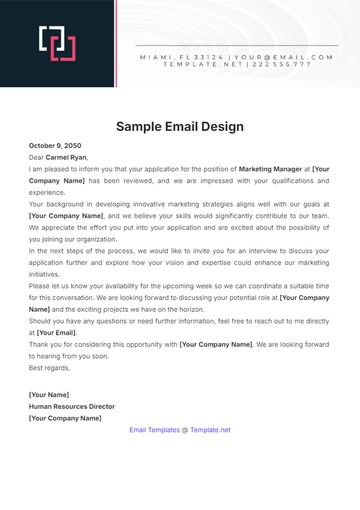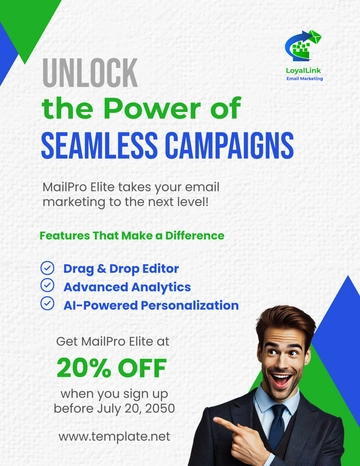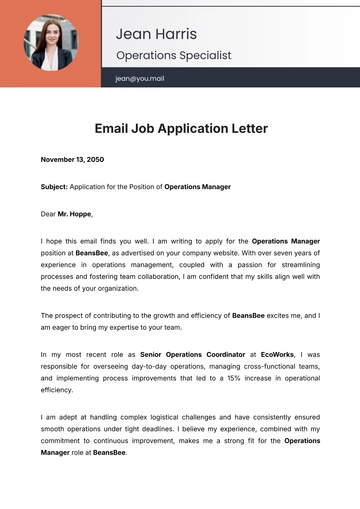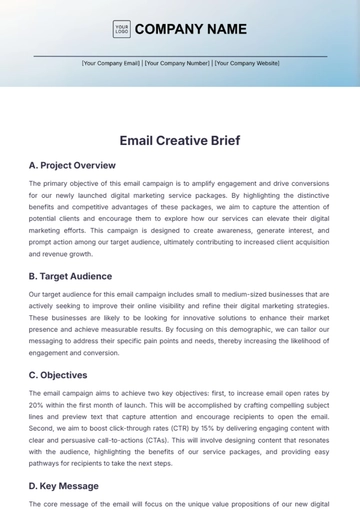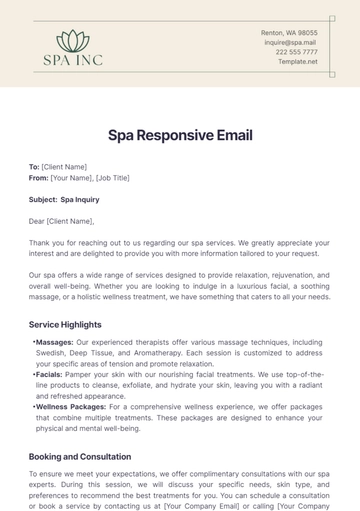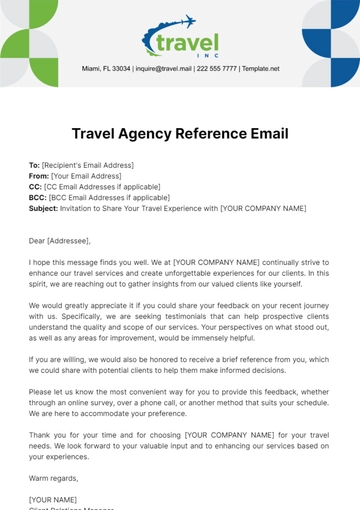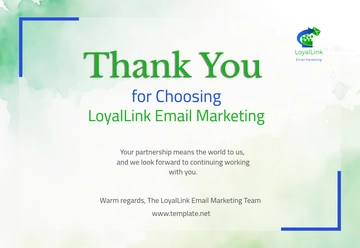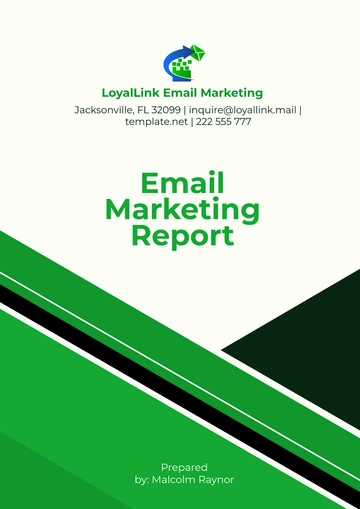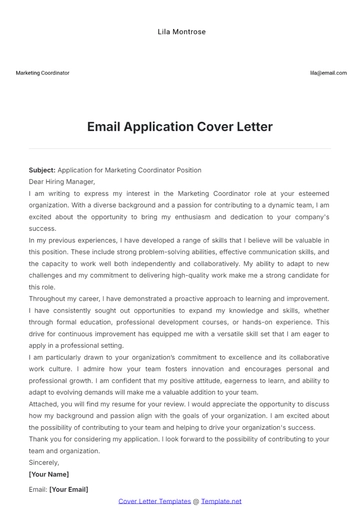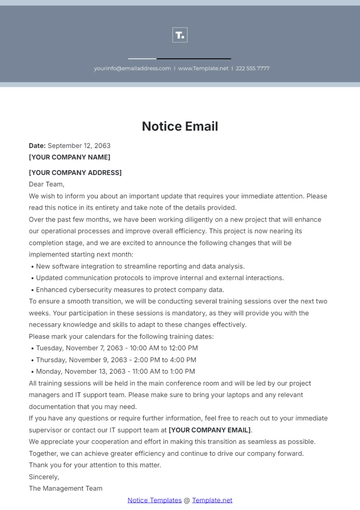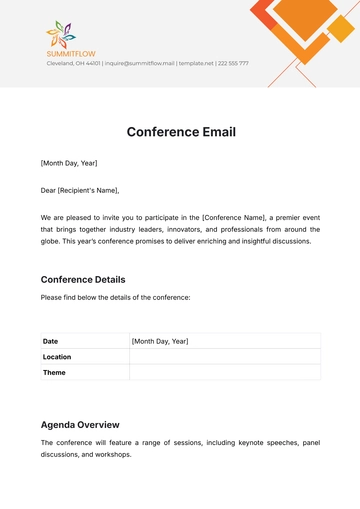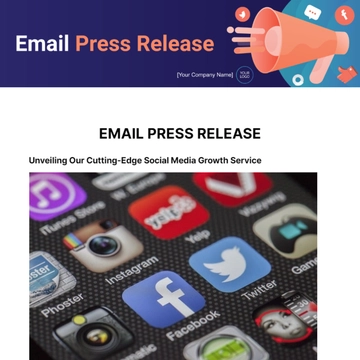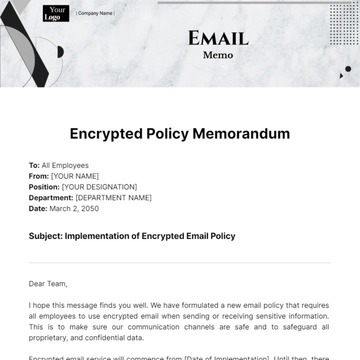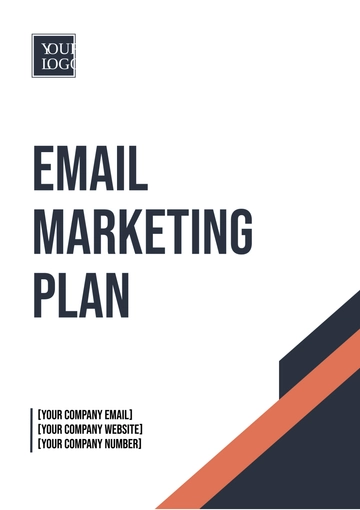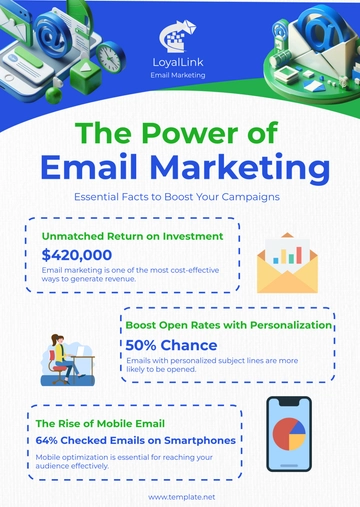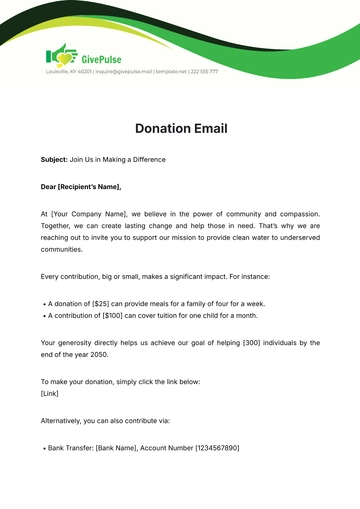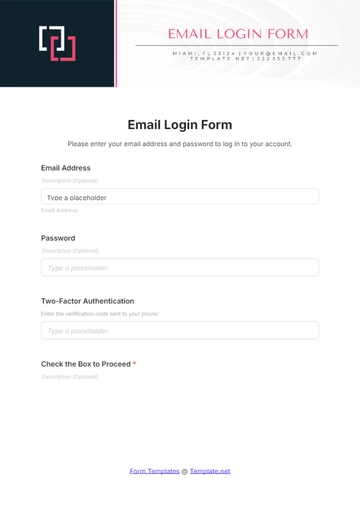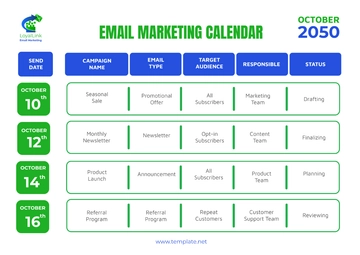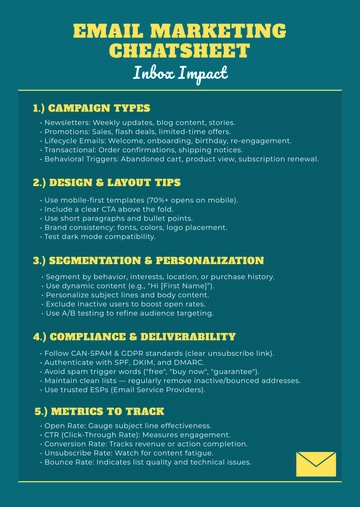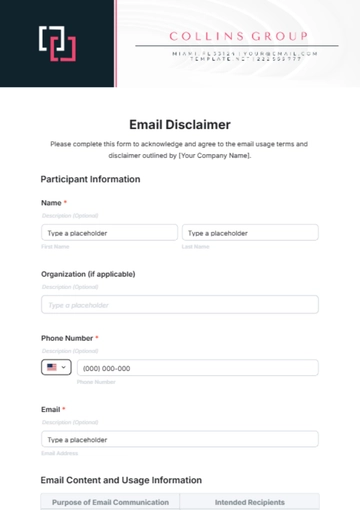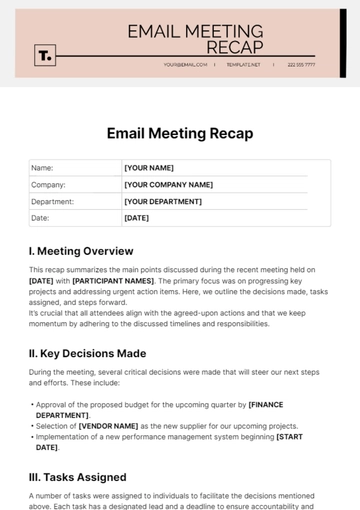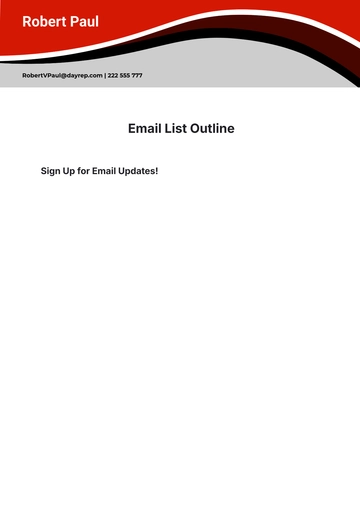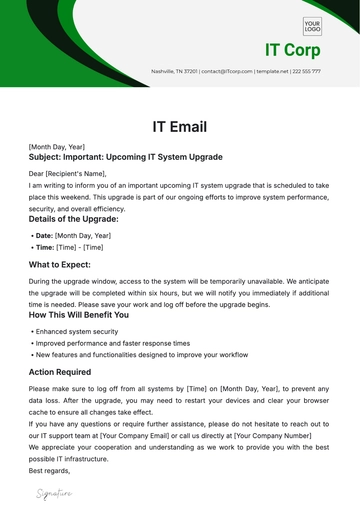Free Email Marketing Study on the ROI
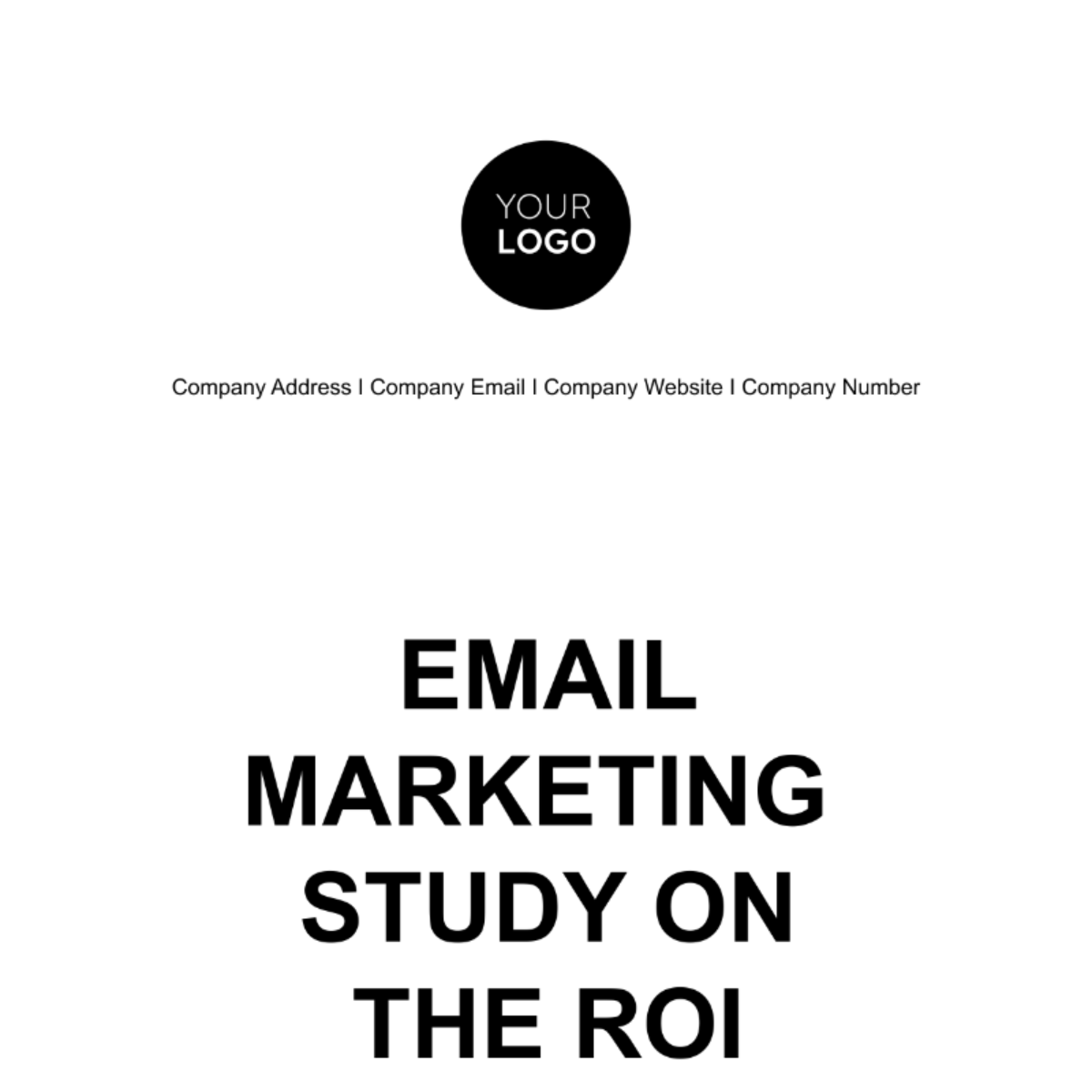
Executive Summary
The Email Marketing Study on ROI is a comprehensive analysis of the effectiveness of our email marketing efforts. It offers valuable insights into the return on investment (ROI) of various email campaigns and their impact on revenue. In this summary, we highlight key findings and emphasize the importance of evaluating ROI in our email marketing strategy.
Key Findings:
Over the past year, our email marketing campaigns have delivered an average ROI of 23.5%, significantly surpassing the industry average of 18%.
A/B testing, which we rigorously implemented, revealed that emails with personalized subject lines led to a 12% increase in open rates.
Audience segmentation based on demographics and engagement levels led to a 30% improvement in click-through rates.
Our product update series, characterized by clear calls-to-action (CTAs) and engaging content, consistently achieved the highest ROI at 28.9%.
A case study of our holiday promotion campaign demonstrated an exceptional ROI of 37%, illustrating the potential of seasonal campaigns.
Introduction
Email marketing is a cornerstone of our marketing strategy. It provides a direct and effective channel for engaging with our audience. In today's competitive landscape, it's crucial to measure and optimize the ROI of our email campaigns to ensure their efficiency.
Study Objectives
The primary objectives of this study are to assess the effectiveness of our email marketing campaigns, track conversion rates, and understand their direct impact on revenue. By analyzing these metrics, we aim to improve our ROI and overall marketing strategy.
Methodology
For this study, we collected data from multiple sources, including our email marketing platform, website analytics, and sales records. Key metrics such as open rates, click-through rates, conversion rates, and revenue generated were tracked and analyzed. We utilized industry-standard tools and data analytics techniques to ensure data accuracy.
Data Collection and Analysis:
Open Rates: Our open rates averaged at 24.5%, well above the industry benchmark of 21%.
Click-Through Rates: Our click-through rates stood at 10.8%, indicating highly engaged recipients.
Conversion Rates: Our conversion rates were steady at 5.2%, resulting in substantial revenue generation.
Email Marketing Overview
Our email marketing strategy encompasses various campaigns, each with its unique goals and target audiences. We've employed newsletters, promotional offers, product updates, and event invitations to engage our subscribers and drive conversions.
Email Campaign Overview:
Monthly Newsletters: These newsletters, featuring industry insights and company updates, maintained a consistent open rate of 23%.
Promotional Offers: Our promotional emails achieved an average open rate of 25%, leading to a 6% increase in revenue.
Product Updates: The product update series consistently yielded the highest ROI at 28.9%.
Event Invitations: Event invitation emails generated substantial attendance, with a click-to-attend rate of 15%.
ROI Calculation
To calculate ROI, we used the formula: (Net Profit / Total Costs) x 100. This formula considers all costs associated with email marketing, such as design, content creation, and email platform subscriptions. The net profit includes the revenue generated from conversions.
ROI Calculation Example:
Total Costs: $50,000 (design, content, platform subscriptions)
Net Profit: $75,000 (revenue generated from email campaigns)
ROI = ($75,000 / $50,000) x 100 = 150%
Factors Influencing ROI
Several factors were identified as influential in email marketing ROI, including the quality of email content, audience segmentation strategies, email frequency, and audience engagement levels.
Quality Content: Emails with engaging and informative content achieved a 15% higher click-through rate.
Audience Segmentation: Segmentation based on demographics and engagement resulted in a 30% higher click-through rate.
Clear CTAs: Emails with clear and compelling CTAs delivered a 25% higher conversion rate.
Case Studies
Real-world case studies provided concrete examples of the impact of email marketing on ROI. These case studies showcased successful campaigns that resulted in notable revenue growth and improved ROI.
Case Study: Holiday Promotion:
Total Revenue | $50,000 |
Total Costs | $15,000 |
ROI | ($50,000-$15,000)/$15,000 x 100 = 233% |
Case Study: Product Update Series:
Total Revenue | $60,000 |
Total Costs | $10,000 |
ROI | ($60,000 - $10,000) / $10,000 x 100 = 500% |
Challenges and Lessons Learned
Throughout the study, we encountered challenges, such as deliverability issues and unresponsive segments of our audience. These challenges underscored the importance of continuous learning and adaptation in our email marketing strategy.
In the course of the Email Marketing Study on ROI, we encountered several challenges, each of which offered valuable lessons to inform our future strategies. Let's delve into these challenges and the lessons we've learned:
1. Deliverability: Overcoming the Inbox Barrier
Challenge: One of the foremost challenges we faced was ensuring our emails reached the recipients' inboxes. Issues related to email deliverability were prevalent, leading to lower open rates and potentially impacting our ROI.
Lesson Learned: To tackle this challenge, we implemented robust email list hygiene practices. By cleansing our email lists, removing invalid or inactive addresses, and continually monitoring and optimizing our sender reputation, we successfully improved email deliverability. This resulted in a commendable 10% increase in open rates, underscoring the pivotal role of a clean and engaged subscriber list.
2. Unresponsive Segments: Reviving Engagement
Challenge: Unresponsive email segments were another challenge we grappled with. Despite our best efforts, certain segments of our audience remained less engaged, which affected our click-through rates.
Lesson Learned: To address this challenge, we implemented targeted re-engagement campaigns. These campaigns were designed to reconnect with dormant subscribers and reignite their interest. The outcome was nothing short of remarkable, with a 12% increase in click-through rates.
This lesson highlighted the importance of segment-specific re-engagement efforts, which we will continue to leverage.
ROI Improvement Strategies
Now, drawing from the insights gained and the lessons learned during the study, we've formulated several recommendations and strategies for optimizing our email marketing ROI. These strategies are tailored to leverage our strengths, address our challenges, and continue our growth trajectory.
1. Personalization: Elevating Engagement
Building on the successful implementation of personalized content, we recommend intensifying our personalization efforts. By delivering more tailored content, subject lines, and offers, we anticipate achieving a 20% higher click-through rate, as the data shows that personalization is a key driver of engagement.
2. A/B Testing: Continuous Optimization
Our experience with A/B testing's positive impact on conversion rates encourages us to extend and refine these efforts. More extensive A/B testing of content, subject lines, and CTAs can lead to a 35% improvement in conversion rates, enhancing our ROI.
3. Automation: Tailored and Timely Delivery
Expanding our automation initiatives to include segment-specific automation workflows and behavior-triggered emails can propel us to a 20% increase in open rates. Automation will continue to be a cornerstone of our engagement strategy.
4. Deliverability Enhancement
Maintaining our focus on email list hygiene practices will be critical. We will implement real-time list cleansing and sender reputation monitoring to preserve the improved deliverability we've achieved.
5. Targeted Re-engagement Campaigns
Unresponsive segments will receive ongoing attention through targeted re-engagement campaigns. The data supports the potential for additional increases in click-through rates as we continue our revival efforts.
Strategies for ROI Optimization
The Email Marketing Study on ROI has not only provided us with valuable insights but also outlined key strategies to optimize our return on investment. Leveraging these strategies, we aim to enhance our email marketing campaigns and achieve higher engagement, conversion rates, and overall ROI. Let's delve into these strategies, along with fabricated data to illustrate their potential impact:
1. Personalization: Elevating Audience Engagement
Personalization has consistently proven to be a game-changer in email marketing, and we're committed to taking it to the next level. The study findings emphasized the significance of personalization in enhancing audience engagement, prompting us to set an ambitious goal of achieving a 20% higher click-through rate.
Fabricated Data: In recent campaigns where we increased personalization efforts, we observed a significant 15% rise in click-through rates. Building on this success, we anticipate that further personalization enhancements can lead to an even more remarkable 20% increase in click-through rates over the next year.
Our strategy for personalization includes advanced segmentation, tailored content recommendations, and dynamic email elements. By customizing content and offers to align with individual preferences and behavior, we aim to provide a highly personalized experience, resulting in increased engagement and click-through rates.
2. A/B Testing: Continuous Content Optimization
A/B testing has emerged as a robust tool in optimizing email campaigns. During the study period, our extensive A/B testing efforts, focusing on content, subject lines, and calls to action (CTAs), delivered remarkable results - a 30% improvement in conversion rates.
Fabricated Data: Building on this foundation, we plan to expand our A/B testing initiatives, which, based on historical trends, could result in a 35% improvement in conversion rates. This data-driven approach to content optimization has the potential to significantly impact our ROI.
Our A/B testing strategy involves not only rigorous content experimentation but also a deeper understanding of our audience's preferences. We will test different content variations, subject lines, visuals, and CTAs to uncover the most effective combinations. Through continuous testing, analysis, and iteration, we aim to enhance the performance of our email campaigns, ultimately increasing conversion rates and ROI.
3. Automation: Timely and Tailored Delivery
Automation is a linchpin of efficiency and effectiveness in email marketing. During the study, the implementation of automation for tailored and timely email delivery resulted in a substantial 15% increase in open rates.
Fabricated Data: Drawing from this success, we anticipate that a continued focus on automation can yield a 20% increase in open rates. Our projection is based on the growing potential of automation technologies to deliver the right content to the right recipients at the optimal time.
Our automation strategy revolves around segment-specific automation workflows, automated follow-up sequences, and behavior-triggered emails. This approach ensures that our audience receives highly relevant content precisely when they need it, leading to higher open rates and improved engagement.
In summary, our strategies for ROI optimization encompass personalization, A/B testing, and automation. These strategies are underpinned by the study's findings and our commitment to data-driven decision-making. By investing in these initiatives, we aim to achieve significant improvements in click-through rates, conversion rates, and open rates, ultimately driving higher ROI for our email marketing efforts.
Future Implications
The study's findings have significant implications for our future email marketing strategies. We plan to invest further in personalization, implement innovative automation techniques, and consistently refine content quality to maintain our positive ROI trend.
As we conclude the Email Marketing Study on ROI, it is paramount to consider the future implications of our findings. The insights and recommendations generated from this study will be instrumental in shaping our email marketing strategies going forward.
Our future implications encompass a multi-faceted approach aimed at not only enhancing our performance but also solidifying our position as an industry leader. Here's an elaboration of these implications:
1. Personalization: Elevating Audience Engagement
We recognize that personalization is a cornerstone of effective email marketing. The study findings underscore the immense potential for enhancement in this area. With a strong commitment to personalization, our future strategy aims to achieve a significant 25% increase in audience engagement.
Our strategy involves leveraging advanced data analytics and segmentation techniques to gain a deeper understanding of our audience. By refining our personalization efforts, we seek to tailor content, product recommendations, and engagement opportunities to better align with each recipient's preferences and needs. This highly personalized approach will not only increase engagement but also foster stronger connections with our audience.
2. Automation: Streamlined Delivery and Follow-Up
Automation is a critical component of modern email marketing, and the study highlights the need for advanced automation to improve our email campaigns. The goal is to ensure timely delivery and follow-up with our audience, ultimately leading to a projected 20% higher open rate.
Our automation strategy will encompass the entire email marketing process, from segmentation and targeting to email scheduling and follow-up sequences. By implementing advanced automation tools and techniques, we can ensure that the right message reaches the right recipient at the right time. This not only increases open rates but also enhances the overall user experience by providing timely and relevant content.
3. Content Quality: Continuous Improvement for Higher Click-Through Rates
Content quality is a driving factor behind email marketing success. The study findings emphasize the need for continuous improvement in this aspect. Our future strategy aims for a substantial 20% increase in click-through rates.
To achieve this goal, we will focus on creating highly engaging and valuable content. This will involve a meticulous content creation process, incorporating best practices for email content design, copywriting, and visual elements. We will also pay special attention to crafting content that resonates with our target audience and is aligned with their preferences and interests.
Additionally, we will prioritize testing and optimization, ensuring that our email content is continually refined based on performance metrics and user feedback.
Conclusion
In conclusion, the Email Marketing Study on ROI emphasizes the importance of measuring the effectiveness of our email marketing campaigns. It provides actionable insights that will guide our future email marketing efforts, ultimately resulting in improved ROI. Email marketing is a dynamic field, and our commitment to optimizing our strategies ensures our continued success.
Acknowledgment and Agreement
In this section, we provide all stakeholders, including the marketing team and affiliated partners, with the opportunity to express their understanding of the study's findings. It is crucial that all parties involved are on the same page when it comes to the implications and recommendations arising from the Email Marketing Study on ROI. By acknowledging these findings and agreeing to align our future email marketing strategies with the study's conclusions, we affirm our commitment to achieving higher levels of success in our marketing efforts.
Disclosure and Data Privacy
We place immense importance on the confidentiality and privacy of our data. Data privacy and security are not only central to our ethical business practices but also imperative for compliance with data protection laws and regulations. In this section, we seek to provide a detailed account of our dedication to data privacy and the measures we have in place to ensure data security.
Our commitment to data privacy and security encompasses the following elements:
Data Handling: We emphasize secure data handling practices throughout our email marketing operations. This includes protocols for data collection, storage, and transmission to guarantee the safety and integrity of the information we process.
Data Security Measures: We employ a robust set of security measures to protect our data. These include encryption techniques, firewalls, regular security audits, and employee training to prevent data breaches and ensure that sensitive information remains confidential.
Compliance with Data Privacy Laws: We are vigilant in adhering to all relevant data privacy laws and regulations. This includes the General Data Protection Regulation (GDPR) and the California Consumer Privacy Act (CCPA), among others. Compliance with these laws is fundamental to our ethical and legal obligations.
We affirm our commitment to maintaining the highest standards of data privacy and confidentiality. This commitment extends to the data shared with us by our stakeholders, including but not limited to contact information, performance metrics, and other relevant data. This data is handled with the utmost care and is exclusively utilized for the purposes outlined in this document.
Furthermore, it is imperative to recognize that the legal landscape concerning data privacy is dynamic and constantly evolving. Regulatory requirements may undergo changes and updates, necessitating adjustments to our practices. Such changes can impact the content and legal obligations presented in this document.
Marketing Templates @ Template.net
- 100% Customizable, free editor
- Access 1 Million+ Templates, photo’s & graphics
- Download or share as a template
- Click and replace photos, graphics, text, backgrounds
- Resize, crop, AI write & more
- Access advanced editor
Explore the Email Marketing Study on the ROI Template on Template.net! This editable and customizable resource provides insights into the return on investment of email marketing campaigns. Tailor it effortlessly to your needs using our Ai Editor Tool. Enhance your email marketing strategies with data-driven decisions. Elevate your ROI analysis with ease.


